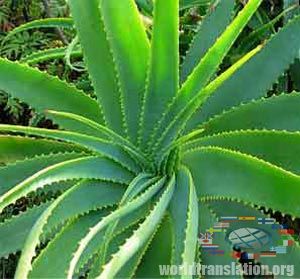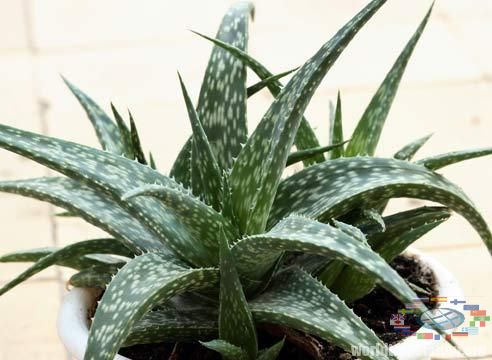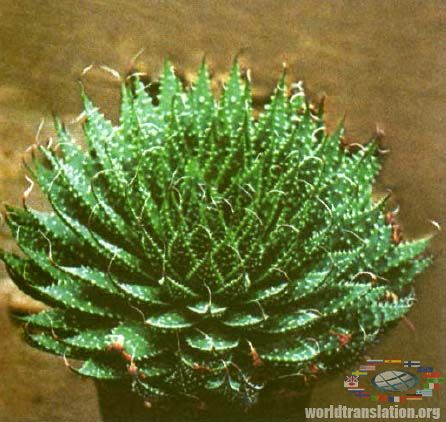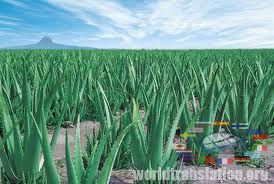Aloe

 Aloe Vera - succulent plant, family - asphodeloideae. South and tropical Africa is aloe homeland. Grows in the deserts a wild kind meets in eastern India and Mediterranean. At home, most often is grown aloe vera (A. arborescens), it blooms very rare, so among the people it is called "century plant".
Aloe Vera - succulent plant, family - asphodeloideae. South and tropical Africa is aloe homeland. Grows in the deserts a wild kind meets in eastern India and Mediterranean. At home, most often is grown aloe vera (A. arborescens), it blooms very rare, so among the people it is called "century plant". Aloe stores water in thick, fleshy leaves ( leaf length of 30 to 60 centimeters), the edges of which are soft spikes. The leaves are gray-green in color, a small plaque of wax protects the plant from moisture evaporation. By the way, the wax makes the leaves water resistant, so if drops of water fall on the plant, they easily roll from the surface, as a balls.
Aloe stores water in thick, fleshy leaves ( leaf length of 30 to 60 centimeters), the edges of which are soft spikes. The leaves are gray-green in color, a small plaque of wax protects the plant from moisture evaporation. By the way, the wax makes the leaves water resistant, so if drops of water fall on the plant, they easily roll from the surface, as a balls.
Aloe can be referred to the undemanding plants, it grows well in the bright rooms. In summer the plant needs to be watered and sprayed abundantly, the main thing to avoid fluid retention in the pan, it needs a monthly feeding with mineral and organic fertilizers. In warmer months, the pot with the plant can be taken on the balcony, protect it from drafts. In autumn until frost aloe need to be taken into the room, watering is produced when earth dries. In winter watering is economical, also protect aloe from the hot air, coming from the radiator and battery. Spring requires trans planting - young plants should be trans planted every year, adults - 2-3 years. It is best developed in the heavy ground mixture, so add finely chopped brick or crushed charcoal to the ground to protect the roots against rot.
You can "force" aloe vera to bloom at home, to do this you need in winter to create the extreme conditions (dryness and the coolness), after some time it should be taken into the room, then you may receive a long peduncle. Flowers are collected in inflorescence, color - red-orange. Attention! The flowers emit a smell that can cause headaches. Usually aloe is propagated by cuttings and offsprings, rarely by seeds. Plants shears must be processed by the crushed coal and leave for a while in the air. Then they should be planted in the sand, and after rooting trans planted into a pot.
Usually aloe is propagated by cuttings and offsprings, rarely by seeds. Plants shears must be processed by the crushed coal and leave for a while in the air. Then they should be planted in the sand, and after rooting trans planted into a pot.
Mealybug can hit aloe, if this happens, remove the pest with a cotton swab which is wetted with soapy water or alcohol. About a day after processing aloe leaves should be washed with clean water. Procedure should be performed weekly until complete elimination of the pest.
The use of aloe
 In Africa, a wild plant used as a fence, in some regions of India juice of Jafarabad aloe is used for paintworks. Aloe fibers are suitable for producing of carpets and marine ropes. In addition, aloe is well-known herbal doctor, with it juice people cure heartburn and treat wounds. Aloe juice with honey helps to strengthen the immune system of the body. It should be noted that aloe juice is contraindicated for people who suffer from heart diseases, those who have severe bowel disorders, kidney and liver diseases, and also its use is not recommended for pregnant women.
In Africa, a wild plant used as a fence, in some regions of India juice of Jafarabad aloe is used for paintworks. Aloe fibers are suitable for producing of carpets and marine ropes. In addition, aloe is well-known herbal doctor, with it juice people cure heartburn and treat wounds. Aloe juice with honey helps to strengthen the immune system of the body. It should be noted that aloe juice is contraindicated for people who suffer from heart diseases, those who have severe bowel disorders, kidney and liver diseases, and also its use is not recommended for pregnant women.